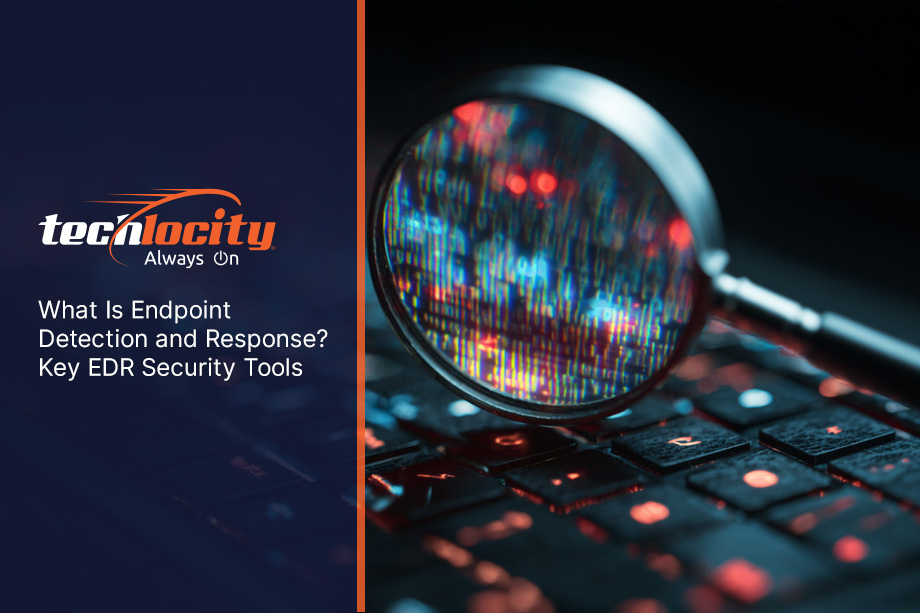(Mon-Sun) 24/7
317-288-5474Talk to us
November 19, 2025

Understanding how to protect your business devices is no longer optional. With cyber threats becoming more advanced, knowing what endpoint detection and response (EDR) is can help your security team stay ahead. In this blog, you’ll learn what EDR is, how it works, why it matters, and what to look for in an EDR solution. We’ll also cover key features, common challenges, and best practices for implementation. If you're exploring endpoint protection or already using an endpoint protection platform, this guide will help you make smarter decisions.
Endpoint detection and response (EDR) is a cybersecurity technology that monitors endpoint devices—like laptops, desktops, and servers—for suspicious activities. It collects and analyzes data from these devices to detect threats in real time and respond quickly.
Unlike traditional antivirus tools, EDR provides deeper visibility into endpoint activities. It helps identify advanced threats that may bypass standard defenses. EDR security tools are especially useful for businesses that need to protect sensitive data and maintain a strong security posture.
EDR technologies work by continuously recording endpoint data and using analytics to detect unusual behavior. When a threat is detected, the system can alert your security analysts or take automated actions like isolating the device or stopping a process.

To understand how EDR works, it helps to break down the core elements that make it effective. Here are several components that define a strong EDR system:
EDR tools monitor endpoint activities around the clock. This allows your security team to detect threats as they happen, not after damage is done.
EDR collects detailed endpoint data, including file activity, process behavior, and network connections. This data is analyzed to spot patterns that indicate threats.
Modern EDR uses machine learning and behavioral analysis to detect suspicious activities. These algorithms help identify threats that traditional tools might miss.
When a threat is detected, EDR can take immediate action—like isolating a device or killing a malicious process—to contain the threat before it spreads.
EDR solutions often include tools that help your team investigate and respond to incidents. This includes timelines, root cause analysis, and remediation steps.
A good EDR system integrates with your existing security solutions, like firewalls and SIEM platforms, to provide a complete view of your environment.
Cloud-based endpoint detection allows for centralized control and easier updates, especially useful for businesses with remote or hybrid teams.
An EDR system should offer these core features to be truly effective:

EDR is a key part of a modern security strategy because it helps detect and respond to threats that other tools may miss. It provides the visibility and control needed to protect endpoints against advanced attacks.
Traditional antivirus tools can’t always detect new or sophisticated threats. EDR fills that gap by analyzing behavior and identifying patterns that suggest malicious activity. This makes it easier for your security team to respond quickly and reduce the impact of an attack.
EDR adoption is growing because businesses need more than just prevention—they need detection and response. With EDR, you can improve your overall security posture and better protect your data, systems, and users.
EDR tools offer a range of capabilities that support your broader cybersecurity efforts. Here’s a closer look at what these systems can do:
EDR uses behavioral analysis and machine learning to detect threats that signature-based tools miss. This includes zero-day attacks and fileless malware.
You get a clear view of what’s happening on every endpoint. This helps identify unusual behavior and track the source of an attack.
EDR can automatically respond to threats by isolating devices, stopping processes, or alerting your team. This reduces response time and limits damage.
Many EDR platforms include or connect to threat intelligence feeds. This helps your team stay updated on the latest attack methods and indicators of compromise.
EDR stores endpoint data over time, allowing you to investigate past incidents and understand how an attack unfolded.
Some EDR systems are part of a broader XDR platform, which combines data from endpoints, networks, and cloud systems for more comprehensive protection.

If you're considering EDR, start by assessing your current endpoint security solution. Identify gaps in visibility, detection, and response. Then, evaluate EDR tools that align with your needs and budget.
Make sure the EDR solution integrates with your existing security tools. Look for features like real-time monitoring, automated responses, and support for incident response. Also, consider whether a cloud-based or on-premises deployment makes more sense for your team.
Train your security analysts on how to use the EDR platform effectively. Regularly review alerts, update detection rules, and refine your response workflows to get the most value from the system.
Follow these best practices to get the most out of your EDR investment:
A strong EDR strategy can significantly improve your ability to detect and respond to threats.

Are you a business with 25 to 150 employees looking for a better way to protect your devices and data? If you're growing and need more visibility into your IT environment, it's time to consider EDR.
At Techlocity, we help businesses like yours understand, implement, and manage endpoint detection and response solutions. Our team works with you to choose the right tools, set up effective monitoring, and respond to threats quickly. Contact us to learn how we can support your security goals.
Antivirus software focuses on preventing known threats using signature-based detection. It works well for basic protection but often misses advanced or unknown attacks. Endpoint detection and response, on the other hand, monitors endpoint activities in real time and uses behavior analysis to detect suspicious activities.
EDR provides deeper visibility and response capabilities. It collects endpoint data, supports incident response, and helps your security team detect and respond to threats that antivirus tools might miss.
An EDR solution helps your team quickly investigate and respond to security incidents. It provides detailed logs, timelines, and root cause analysis tools that make it easier to understand what happened and how to fix it.
With built-in response capabilities, EDR can isolate endpoints, stop malicious processes, and support recovery efforts. This reduces downtime and limits the impact of an attack.
Endpoint security is essential because every device connected to your network is a potential entry point for attackers. Small to midsize businesses often lack the resources for a full security team, making strong endpoint protection even more important.
A reliable endpoint security solution helps detect threats early, protects sensitive data, and supports compliance. It also gives your team the tools to respond quickly when something goes wrong.
Focus on components that offer real-time monitoring, automated response, and threat intelligence integration. These features help you detect and respond to threats faster.
Also, look for tools that provide historical data analysis and support for extended detection and response. These capabilities make it easier to investigate incidents and improve your overall security posture.
Threat intelligence provides up-to-date information on known threats, attack methods, and indicators of compromise. When integrated with EDR, it helps detect threats more accurately and respond faster.
It also allows your security analysts to stay ahead of emerging risks. This improves detection rates and reduces false positives, making your EDR tool more effective.
Before adopting EDR, assess your current security tools and identify gaps in visibility and response. Consider your team’s skills, budget, and the types of threats you face.
Choose a solution that fits your environment and integrates with your existing systems. Make sure it provides the visibility, response capabilities, and support your business needs to stay secure.
[.c-button-wrap][.c-button-main][.c-button-icon-content]Contact Us[.c-button-icon][.c-button-icon][.c-button-icon-content][.c-button-main][.c-button-wrap]